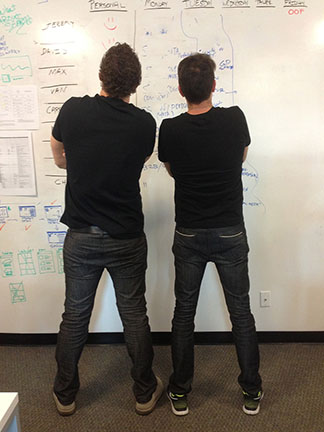I'm a big believer in the power of collaboration. And working at BeyondCurious has only reinforced my commitment to integrated teamwork. That's because at an agile startup, collaboration is not just a nice thing to have. It's absolutely critical for effective communication and rapid iteration. Most importantly, it ultimately helps ensure that we produce great work.
A recent debate in the larger design/research community has got me thinking about how I ended up valuing collaborative work, and why I think it's so important.
I'm a member of several online design research groups. When I woke up and checked my email on Monday morning, I was distressed to see a long, not-so-nice email debate about researchers and designers working together.
The comment that instigated the debate was from a designer. She asked how researchers and designers can get along, complaining that research is annoying and a hassle to deal with. Understandably, that comment raised some hackles with the researchers on the list. But then she suggested that designers should be included in research planning, fieldwork, and synthesis. The reactions to that part of her comment disturbed me.
The crux of the debate, and indeed the assumption in the majority of responses, was that designers and researchers are, if not natural enemies, at least part of very different camps, and that working together will necessarily present a challenge.
A Call for Integration
I'd like to propose a different frame of mind. It is modeled in part on the integrated teamwork that I learned at a design research consultancy called Elab where I worked in the late nineties. Elab's approach was to marry a designer and a researcher as core team members throughout the project. There was no "throwing things over the fence" because there was no fence. Researchers and designers planned, did fieldwork, conducted analysis, and built models together. Period. Elab's co-founders Rick Robinson and John Cain (a researcher and a designer) set up a beautiful model when they replicated their own partnership in Elab's team structure.
Integrated Teams atBeyondCurious
BeyondCurious is not a research firm; we're a digital innovation company, so our teams include research, design, technology, and strategy. But we operate as integrated teams. Really integrated. We're always doing things to try to push ourselves to integrate further, because we think it matters to our culture, and because we think it's the best way to produce great work. We've seen that the more connected we are, the better.
For example, I work not only with the design team, but also with the tech lead, and the strategy lead, to come up with approaches and solutions to our clients' business problems. And I love it! It is a complete thrill to put our collective specializations together to problem solve. We are all professionals with years of experience in our different disciplines. But the true magic happens when we combine the power of our different perspectives.
This week's Question:
What does collaboration mean where you work? Is it a disaster? A joy? What do you think companies could be doing better to foster integration and collaboration?
As always, I welcome your thoughts, insights, and questions about any of the above.
You can follow Beyond Curious on twitter @beyond_curious, or on Facebook.
